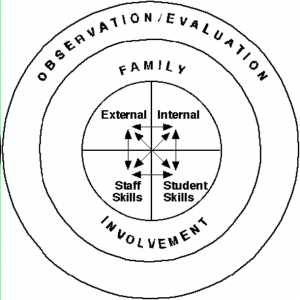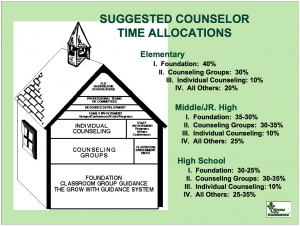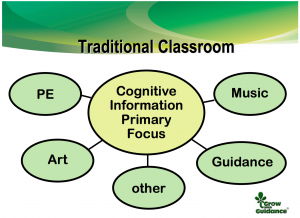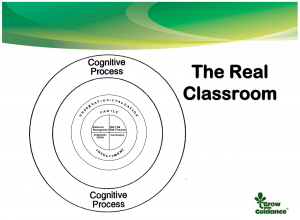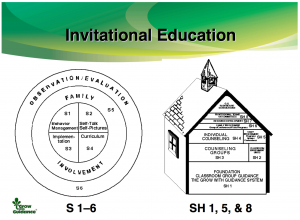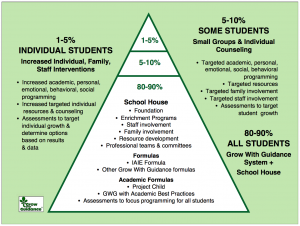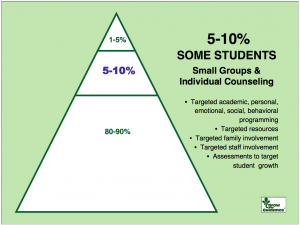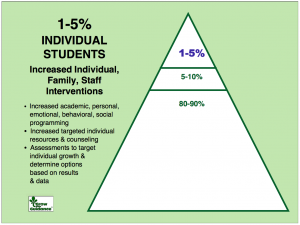Creating the Climate and Culture Needed for Successful Response to Intervention – A Systems Approach.
This presentation demonstrates ways that a Guidance Systems approach creates an inviting school climate while effectively meeting the learning needs for all students with an RTI process that works. Participants will learn about the System and RTI while exploring ways the System supports the whole child’s development in an inviting climate and culture. The impact of Social Emotional Learning Programs is documented by recent research to increase academic achievement test scores by up to 11 percentile points. Contact us with questions and comments.
Grow With Guidance RTI Presentation [.pdf] 17.3MB
Creating the Climate and Culture Needed for Successful Response to Intervention – A Systems Approach
Agenda
- Introduction
- An Overview of Guidance System Components – Key to an Inviting Classroom
- System Components
- Behavior Management (extrinsic)
- Self-Talk/Self Pictures (intrinsic)
- Curriculum (student skills)
- Implementation (staff skills)
- Family Involvement
- Observation/Evaluation
- Life Labs – The Heart of the Real Classroom
- The Invitational Education Formula
- RTI Definition and Pyramid
- Questions & Closing
We can create true democratic classrooms that insist ALL students be accountable and responsible. School environments need to be examples of democracy in action. – Tommie R. Radd, PhD
Remember: The impact of Social Emotional Learning Programs is documented by recent research to increase academic achievement test scores by up to 11 percentile points. The Systems approach demonstrates ways to create an inviting school climate while effectively meeting the learning needs for all students with an RTI process that addresses the needs of the whole child.
Personal, social, emotional and behavioral skills are the only constant in every situation. The level of development of those skills determines if one will respond or react over time. —Tommie R. Radd, PhD
The whole is equal to more than the sum of its parts. ~ Tommie R. Radd, PhD
A comprehensive, developmental guidance system for classrooms and schools with the necessary components for success. Each component is implemented slowly and simultaneously with a 3- to 5-year plan until all system components are in place.
The interactive, interrelated, and interdependent movement between system components.
Overview of a Guidance System
- Behavior Management – Extrinsic – what we say and do
- Self-Talk & Self-Pictures – Intrinsic – what we say and believe with what we think and feel
- Curriculum – Student Skills
- Implementation – Staff Skills
- Family Involvement – Family Skills
- Observation/Evaluation
System Components Implemented
- Congruent
- Systemic – identify all components of the system or whole and understand the relationship between components
- Slowly and simultaneously
- 3-5 year process
- The Whole is larger than the sum of the parts
Classroom Group Guidance System Checklist
-
- Positive Behavior Plan
- Share Benchmarks, Standards, and Indicators
- Self Concept Series/Weave as it relates to Behavior
- Five Star Class Meetings
- Class Responsibilities and Guidelines
- Problem Solving – “Help” vs “Hurt”
- Effective Behavior Interactions
- Problem Ownership
- Cooperative Strategies
- Contracts
- Peer Group Work
- The Five C’s for Maintaining Conflict
- Performance Observation/Evaluation
- Increase Component Implementation Annually
- Self-Talk/Self-Pictures Plan
- Share Benchmarks, Standards, and Indicators
- Self Concept Series/Weave as it relates to Self-Talk/Self-Pictures
- Activity Process General Self-Talk
- Activity Process Specific Self-Talk
- Activity Process General Self-Pictures
- Activity Process Specific Self-Pictures
- Incorporate Relaxation
- Performance Observation/Evaluation
- Increase Component Implementation Annually
- Curriculum Plan
- Share Benchmarks, Standards, and Indicators
- Self Concept Series/Weave as it relates to Student Skills
- Begin Core Activities
- CANA (Children’s Affect Needs Assessment) Administered
- ITS (Invitational Teaching Survey) Administered
- Florida Key Administered
- CANA Pre Report
- ITS Pre Report
- Florida Key Pre Report
- Selective Activities
- Format Implemented for all Activities
- Performance Observation/Evaluation
- Post CANA, Post ITS, and Post Florida Key Tests Administered
- CANA, ITS, and Florida Key Post Reports
- Report summary written including all year-end performance Observation/Evaluation information
- Increase Component Implementation Annually
- Staff Improvement Skills
- Share Benchmarks, Standards, and Indicators
- Self Concept Series/Weave as it relates to Staff
- Overview of the System
- Overview of Behavior Management Component
- Overview of Self-Talk/Self-Pictures Component
- Overview of Staff Implementation Skills
- Overview of Curriculum Component
- Conduct Staff Needs Assessment
- Prioritize Staff Skills
- Encouragement Strategies
- Prioritize Group Techniques
- Prioritize Other Needs Based on the ITS and Needs Assessment
- Performance Observation/Evaluation
- Increase Component Implementation Annually
- Family Involvement
- Share Benchmarks, Standards, and Indicators
- Self Concept Series/Weave as it relates to Family
- Overview of the System
- Overview of Behavior Management Component
- Overview of Self-Talk/Self-Pictures Component
- Overview of Staff Implementation Skills
- Overview of Student Curriculum Component
- Conduct Family Needs Assessment
- Prioritize Skills from Behavior Management Component
- Prioritize Skills from Self-Talk/Self-Pictures Management Component
- Prioritize Skills from Staff Implementation Skills
- Prioritize Skills from Curricular Core and Other Skills
- Performance Observation/Evaluation
- Increase Component Implementation Annually
- Positive Behavior Plan
It is recommended that all system information be included for families when possible.
- Developed a 3-to-5 year plan in the components for simultaneous, slow implementation
- Behavior Management
- Self-Talk/Self-Pictures
- Curriculum
- Implementation Skills
- Family Involvement
Suggested Counselor Time Allocations
Elementary
- Foundation: 40%
- Counseling Groups: 30%
- Individual Counseling: 10%
- All Others: 20%
Middle/JR. High
- I. Foundation: 35-30%
- Counseling Groups: 30-35%
- Individual Counseling: 10%
- All Others: 25%
High School
- I. Foundation: 30-25%
- Counseling Groups: 30-35%
- Individual Counseling: 10%
- All Others: 25-35%
Traditional Classroom
The Real Classroom
Life Lab
A way of defining the classroom as a simulation in which students, pre-K-12 and beyond, learn, experience, and apply the essential skills needed for life; the comprehensive developmental guidance system creates a life lab in every classroom through which students develop a conscious and intentional from of reference that can be applied throughout life.
Joel A. Barker, Futurist
- School is a place that is a “life preparation center.”
- Real live collaboration is 50% of all work in the real world.
Keynote address – Battelle for Kids Value-Added Conference, October 2006
Invitational Education Formula
The Guidance System, Staff Involvement & Professional Teams or Committees
A Conscious and Intentional Plan with the skills and processes needed for a winning invitational education program. A Life Lab of experiences needed for post-school success.
Invitational Education
Invitational Education Formula
Students can develop their spirit, purpose and potential when . . .
- there is a plan for change that is an integral part of the day-to-day operation of a school.
- there is a conscious plan to support the self-concept development of all within a school.
- the perception of students, staff, and families regarding school relationships, procedures, and policies is communicated and modified when it is destructive.
- personal, social, emotional, and behavioral skills are taught.
- students provide ongoing feedback to educators as to their day-to-day experiences in school.
- there is an intentional process for consciously creating an inviting environment for all students.
Response To Intervention (RTI) Definition
Response To Intervention (RTI) is the practice of providing high-quality instruction and interventions matched to student need, monitoring progress frequently to make changes in instruction or goals, and applying child response data to important educational decisions.
80-90% ALL STUDENTS
Grow With Guidance System
+
School House
5-10% SOME STUDENTS
Small Groups & Individual Counseling
- Targeted academic, personal, emotional, social, behavioral programming
- Targeted resources • Targeted family involvement
- Targeted staff involvement
- Assessments to target student growth
1-5% INDIVIDUAL STUDENTS
Increased Individual, Family, Staff Interventions
- Increased academic, personal, emotional, behavorial, social programming.
- Increased targeted individual resources and counseling.
- Assessments to target individual growth and determine options based on results and data.
Assessments
A 43-question diagnostic class climate assessment, taken by students, which gives student input about their classroom experience and whether they have a feeling of being “invited”; a diagnostic tool to involve students and get their input on ways to improve climate and school relationships; one indicator of ways to support staff growth experiences and plans; one way to observe and evaluate change at the end of a school year through pre-post assessment; the school climate assessment included in The Grow With Guidance® System.
A 42-question diagnostic curriculum assessment taken by students that provides student input into their classroom guidance curriculum activity selection; a diagnostic tool to involve students and create a sense of student ownership for guidance skill implementation and change (Note: ownership occurs when students “own” a problem and admit, recognize, and acknowledge personal needs and challenges that support assuming responsibility and commitment for change); assessment questions asked in the five essential learning strands of the curriculum of The Grow With Guidance® System; one way to observe and evaluate change at the end of the school year through pre-post assessment; the student curriculum assessment included in The Grow With Guidance® System.
Many in education, psychology, sociology, and related fields have recognized the significant relationship between selfconcept and school achievement. On the basis of available research, it now appears that students who doubt their ability to learn in school carry with them a tremendous educational handicap. The purpose of The Florida Key is to provide teachers, counselors, and related professionals with a relatively simple instrument designed to measure both inferred and professed student self-concept-as-learner. It provides teachers and related professionals insight into students’ perceptions of themselves as learners. The Florida Key identifies and measures selected student behaviors that are believed by classroom teachers to correlate with positive realistic student self-concepts in the area of school success.
1. All are important and valuable no matter what they think, say, feel, and do.
2. All show they are remembering their worth by making helpful choices toward themselves and others. They are responsible for helping not hurting self and others.
3.All are responsible for their choices. This accountability empowers all to make improvements because of their worth.
NOTE: See Podcast here.
- ISS (see IAIE Web Site)
- Other System Assessment
References
Radd, T. R. (2007). The Grow With Guidance® System Manual. Third Edition. Revised. Omaha, Nebraska: Grow With Guidance. isbn: 978-1-878317-53-7 (1-878317-53-9).
Radd, T. R. (2007). The Grow With Guidance® System Primary Level. Third Edition. Revised. Omaha, Nebraska: Grow With Guidance. isbn: 978-1-878317-54-4 (1-878317-54-7).
Radd, T. R. (2007). The Grow With Guidance® System Intermediate Level. Third Edition. Revised. Omaha, Nebraska: Grow With Guidance. isbn: 978-1-878317-55-1 (1-878317-55-5).
Radd, T. R. (2007). The Grow With Guidance® System Middle School Level. Third Edition. Revised. Omaha, Nebraska: Grow With Guidance. isbn: 978-1-878317-56-8 (1-878317-56-3).
Radd, T. R. (2007). The Grow With Guidance® System High School Level. Omaha, Nebraska: Grow With Guidance. isbn: 978-1-878317-57-5 (1-878317-57-1).
Radd, T. R. (2007). The Grow With Guidance® System Fun Game. Second Edition. Revised. Omaha, Nebraska: Grow With Guidance. isbn: 978-1-878317-49-0 (1-878317-49-0).
Radd, T. R. (2007). The Grow With Guidance® System Music: G.G. Raddbearie Sings. Omaha, Nebraska: Grow With Guidance. isbn: 978-1-878317-47-6 (1-878317-47-4).
Radd, T. R. (2006). The History, Development, and Research of the Educational Systems Model: The Grow With Guidance® System. Omaha, Nebraska: Grow With Guidance. isbn: 978-1-878317-52-0 (1-878317-52-0).
Radd, T. R. (2003). Teaching and Counseling for Today’s World Pre-K–12 & Beyond. Omaha, Nebraska: Grow With Guidance. isbn: 1-878317-48-2.
Radd, T. R. (2003). Classroom Activities for Teachers, Counselors, and Other Helping Professionals Pre-K–12 & Beyond Vols. I & II. Omaha, Nebraska: Grow With Guidance. isbn: 1-878317-45-8, 1-878317-46-6
A complete Research Report is available here.


